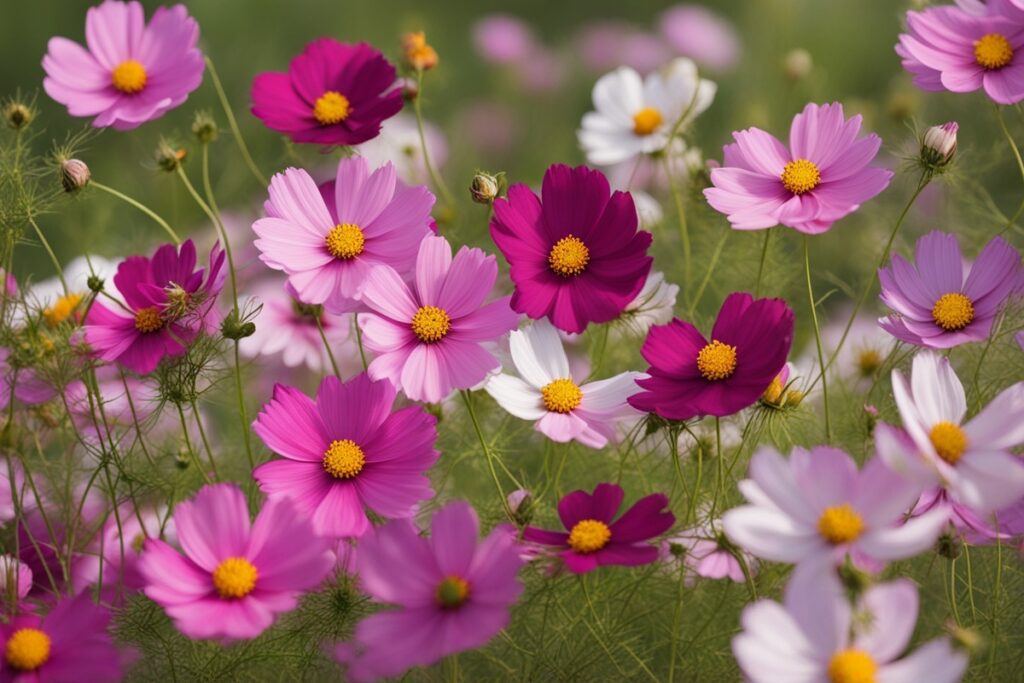Growing cosmos flowers is like inviting a burst of color and whimsy into your garden. If you’ve ever dreamed of a backyard filled with delicate, daisy-like blooms swaying in the breeze, you’re in the right place. Today, we’re diving deep into how to harvest beautiful cosmos flowers soon—from planting seeds to snipping those vibrant petals for your vase. I’ve spent years tinkering with these easy-to-grow annuals, and I’m excited to share tips, tricks, and a few lessons learned the hard way (like the time I overwatered and nearly drowned my poor seedlings!). Whether you’re a seasoned gardener or just starting out, let’s get those cosmos thriving.
Why Cosmos Flowers Are a Gardener’s Dream
Cosmos flowers, with their feathery foliage and bright blooms, are the kind of plant that makes gardening feel effortless. They’re low-maintenance, drought-tolerant, and bloom like crazy from summer to fall. Want to harvest beautiful cosmos flowers soon? Start with understanding why they’re a no-brainer for any garden. These beauties come in shades of pink, white, yellow, and even deep crimson, often attracting pollinators like bees and butterflies. I’ve watched hummingbirds dart around my cosmos patch, and it’s a sight that never gets old. Plus, they’re perfect for beginners since they don’t demand much beyond sunlight and decent soil.
But here’s the kicker: cosmos are prolific self-seeders. Plant them once, and with a little luck, they’ll pop up year after year. Of course, that also means you might need to keep an eye on them if you don’t want a full-blown takeover. Balance is key—enjoy their wild charm, but don’t let them crowd out other plants.
Choosing the Right Cosmos Seeds for Quick Harvests
Not all cosmos are created equal when it comes to speed. If your goal is to harvest beautiful cosmos flowers soon, pick varieties known for fast growth and early blooming. Cosmos bipinnatus, for instance, often flowers within 7-10 weeks of planting, while Cosmos sulphureus (the yellow and orange kind) can be even quicker under ideal conditions. I’ve had great luck with ‘Sensation Mix’—a blend of tall, colorful blooms that seem to explode overnight. Check seed packets for terms like “early blooming” or “short season” to ensure you’re not waiting forever.
Here’s a pro tip: source your seeds from reputable nurseries or online retailers with good reviews. A few years back, I grabbed a cheap packet from a discount store, only to find half the seeds didn’t germinate. Lesson learned—quality matters. Also, consider your climate. If you’re in a cooler zone with a short growing season, prioritize early varieties to beat the first frost.
Planting Cosmos Seeds for Maximum Success
Let’s get down to business—planting is where the magic starts. To harvest beautiful cosmos flowers soon, timing and technique are everything. Sow seeds directly into the ground after the last frost date in your area, usually in late spring or early summer. Cosmos aren’t picky, but they do crave full sun (at least 6 hours a day) and well-draining soil. I’ve made the mistake of planting in a shady corner before, and let me tell you, the results were sad—leggy stems and barely any flowers.
Scatter the seeds lightly over the soil and cover them with just a quarter-inch of dirt. Don’t bury them too deep; they need light to germinate. Water gently to keep the soil moist but not soggy. Imagine you’re dealing with delicate little babies here—too much water, and they’ll rot before they even sprout. Within 7-14 days, you should see tiny green shoots. Thin them out to about 12-18 inches apart once they’re a few inches tall to avoid overcrowding. Trust me, giving them space pays off with bigger, healthier blooms.
Caring for Cosmos to Speed Up Flowering
Once your cosmos are up and running, a little TLC goes a long way. Want to harvest beautiful cosmos flowers soon? Don’t overthink it—these plants thrive on neglect. Water them only during dry spells; their deep roots handle drought like champs. I’ve gone weeks without watering mine during a hot summer, and they still looked stunning. Overwatering, on the other hand, can lead to root rot or weak, floppy stems, so err on the side of caution.
Fertilizer? Skip it, mostly. Too much nitrogen makes them grow tons of leaves but fewer flowers. If your soil is really poor, a light application of balanced fertilizer (like a 10-10-10) at planting is fine. Deadheading—snipping off spent blooms—keeps them flowering longer. I spend a few minutes every week with my shears, and it’s like telling the plant, “Hey, keep the party going!” Also, watch for pests like aphids. A quick blast of water usually sends them packing, no chemicals needed.
Harvesting Your Cosmos Flowers at the Perfect Time
Here comes the rewarding part—harvesting! To harvest beautiful cosmos flowers soon, wait until the blooms are fully open but not fading. Early morning is the best time; the flowers are fresh, and the stems are hydrated. Use sharp scissors or pruners to cut just above a leaf node, leaving a long stem if you’re arranging them in a vase. I’ve found that cutting at an angle helps them drink up water better once indoors.
Don’t be shy about harvesting often—cosmos love it. The more you cut, the more they bloom. Last summer, I made a habit of snipping a handful every few days for my kitchen table, and the plants just kept producing until frost hit. If you’re not cutting for display, deadhead regularly to encourage new buds. And here’s a little secret: save some dried flower heads at the end of the season. Shake out the seeds, store them in a cool, dry place, and you’ve got free plants for next year. How’s that for a win?
Common Pitfalls to Avoid for Faster Results
Even with a plant as forgiving as cosmos, there are a few traps to dodge if you want to harvest beautiful cosmos flowers soon. First, don’t plant too early. I’ve been guilty of jumping the gun in my excitement, only to lose seedlings to a late frost. Check your local frost dates (the USDA Hardiness Zone map is a lifesaver) and be patient. Second, avoid heavy, clay-rich soil. Cosmos hate “wet feet”—if your ground doesn’t drain well, mix in some sand or compost before planting.
Another mistake? Overcrowding. It’s tempting to sow a ton of seeds for a fuller look, but cramped plants compete for light and nutrients, delaying blooms. I learned this the hard way when my first patch turned into a tangled mess. Thin them out early, even if it feels ruthless. Lastly, don’t ignore staking if you’re growing tall varieties like ‘Sensation.’ A strong wind can knock them flat—I’ve had to prop mine up with bamboo stakes after a storm, and it’s not a fun chore. Plan ahead, and you’ll save yourself the headache.
References
- University of Minnesota Extension – Growing Cosmos
- Missouri Botanical Garden – Cosmos bipinnatus
- Colorado State University Extension – Annuals: Cosmos
- Royal Horticultural Society – Growing Cosmos
- Clemson University Cooperative Extension – Cosmos
Disclaimer: This article is for informational purposes only, based on general research and personal experience. It is not intended to serve as a substitute for professional advice. Gardening conditions, plant needs, and individual circumstances can vary widely, so results may differ from those described. Always consult a qualified horticulturist, local extension service, or other gardening professional for personalized guidance tailored to your specific situation. The author and publisher are not responsible for any adverse effects or outcomes resulting from the application of the information provided in this content.
This content is for informational purposes only and not a substitute for professional advice.


